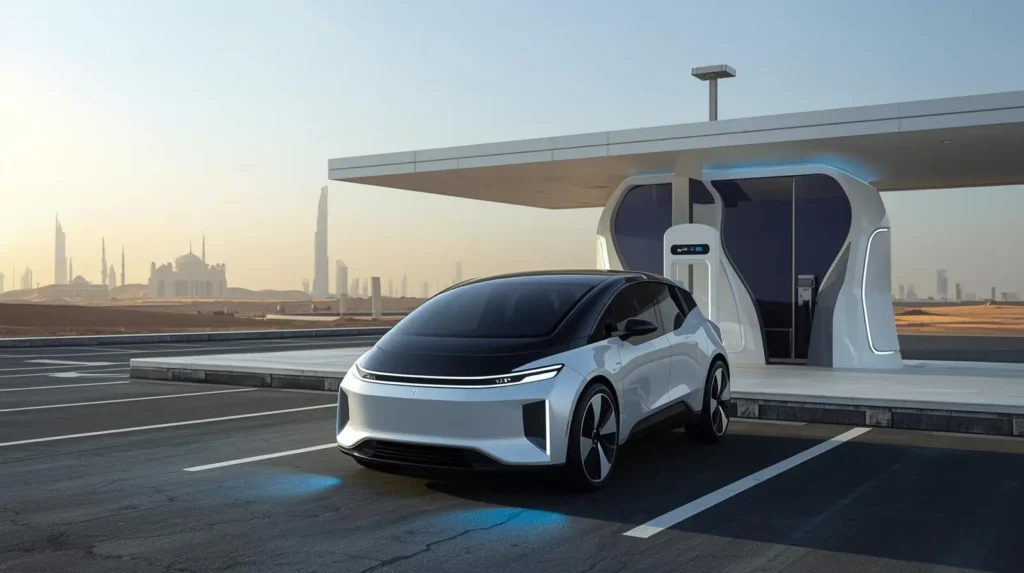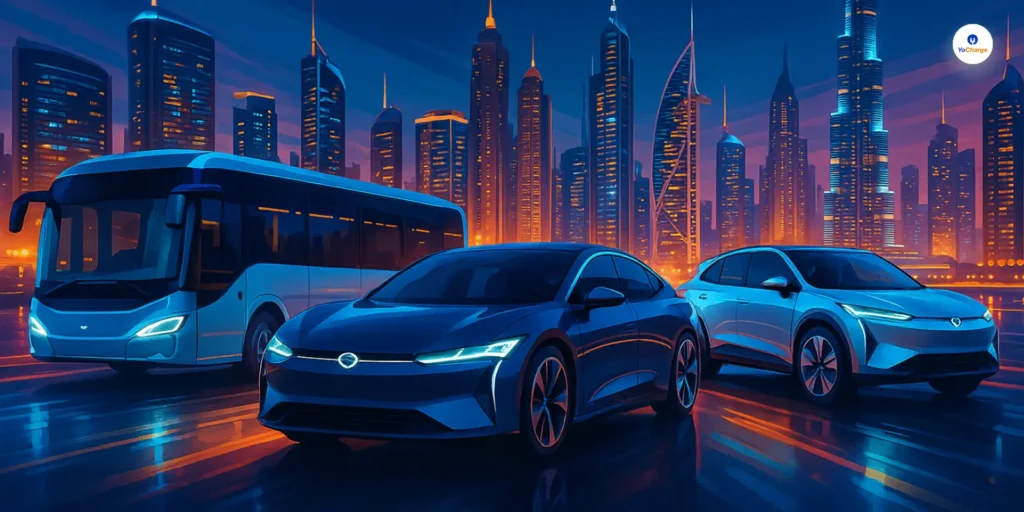
The electric vehicle (EV) revolution is in full swing. As more and more drivers embrace the benefits of zero-emission mobility, the demand for efficient EV charging strategies has become increasingly crucial. At the heart of this transition lies the need to optimize charging habits. Simply plugging in an EV is no longer enough. Savvy EV owners and fleet managers must consider various factors, from electricity costs and grid constraints to individual driving patterns and battery degradation.
Fortunately, various EV charging strategies have emerged to address these challenges. From balanced charging, which balances energy needs with costs and grid stability, to series charging (FIFO) for fleet management, and proportional charging which allocates power based on specific requirements – each strategy offers unique benefits to EV owners. As the EV market grows, understanding these charging strategies and their use cases will be key to ensuring a seamless and efficient charging experience for all.
This article aims to provide an overview of the various EV charging strategies and their use cases, helping you understand the importance of optimizing charging habits and making informed decisions about your EV ownership experience.
Understanding EV charging strategies
Electric Vehicle (EV) charging strategies are more than just plugging in your vehicle. They involve considering various factors to optimize charging habits and ensure efficient use of the charging infrastructure. EV charging strategies differ from simply plugging in an EV because they consider each user’s unique needs and constraints.
Factors influencing EV charging strategies choice
Several factors influence the choice of a charging strategy:
- Electricity Costs: The cost of electricity varies depending on the time of day and the location. Charging during off-peak hours or using time-of-use (TOU) tariffs can help reduce energy costs.
- Grid Constraints: The grid’s ability to handle the increased demand for electricity from EVs is a significant concern. Charging strategies prioritising grid stability and minimising peak demand can help alleviate these concerns.
- Individual Driving Habits: The frequency and duration of EV use and the type of trips taken impact the choice of charging strategy. For example, drivers who commute long distances may require faster charging speeds.
Importance of charging infrastructure availability
When choosing a charging strategy, it is essential to consider the availability of charging infrastructure:
- Charging Speeds: Level 1, Level 2, and DC Fast Charging speeds offer different charging times and capacities. Choosing the right charging speed depends on the user’s needs and the available infrastructure.
- Battery Degradation: Charging strategies that prioritize battery health and minimize degradation can help extend the life of the battery.
Types of EV charging strategies
There are mainly 6 types of EV Charging Strategies to enhance the EV charging experience. You can learn about all 6 EV strategies given below:
Priority charging
Priority charging focuses on assigning higher charging precedence to specific electric vehicles (EVs) based on their necessity and operational criticality. This strategy is particularly useful in fleet management scenarios where certain vehicles need to be ready for use more urgently than others.
For instance, emergency response vehicles, public transport buses, or delivery vans might be prioritized to ensure they are always available when needed. By implementing priority charging, fleet managers can ensure these essential vehicles are charged first, thereby minimizing downtime and improving operational efficiency.
This approach also helps in better utilization of available charging infrastructure, reducing the risk of having critical vehicles offline due to insufficient charge.
Additionally, priority charging can be integrated with smart grid technologies to optimize energy consumption and cost, aligning charging schedules with periods of low electricity demand or lower tariffs. Overall, this strategy enhances the reliability and efficiency of essential services that depend on electric mobility.
Balanced charging
Balanced charging aims to distribute the available power equally among all connected EVs. This strategy ensures that each vehicle receives a fair share of the charging power, preventing scenarios where some vehicles are fully charged while others are left with minimal charge.
Balanced charging is particularly useful in settings with limited power availability, such as workplaces, residential complexes, or public charging stations. By evenly distributing power, this strategy helps in maximizing the usage of the existing electrical infrastructure without overloading it.
It also promotes fairness among EV users, as each vehicle gets a proportional amount of charge over a given period. Implementing balanced charging can involve sophisticated algorithms and real-time monitoring systems to dynamically adjust the power allocation based on the number of connected vehicles and their respective charging needs.
This approach not only improves user satisfaction but also enhances the efficiency of the charging infrastructure, leading to better overall performance and reliability.
Series charging
Series charging, also known as sequential or first come, first served charging, involves charging EVs one after another in the order they are connected. This strategy is straightforward to implement, making it suitable for smaller charging setups or locations with minimal management requirements.
Under this system, the first vehicle to connect starts charging immediately, and subsequent vehicles wait their turn. While this method ensures that each vehicle eventually receives a full charge, it can lead to longer wait times for vehicles that connect later.
Series charging is most effective when the charging demand is relatively low or predictable, such as in private garages or small business fleets.
However, it might not be the most efficient approach in high-demand scenarios, as it does not optimize the use of available power and can lead to idle charging stations while vehicles wait their turn. Despite its simplicity, series charging can be enhanced with basic scheduling tools to manage the queue more effectively.
Proportional charging
Proportional charging allocates charging power based on the specific needs and schedules of the connected EVs. This strategy takes into account factors such as the departure time, current state of charge, and required battery level, distributing power accordingly.
For example, a vehicle that needs to leave sooner or requires more charge will receive a higher proportion of the available power compared to others. Proportional charging is ideal for optimizing energy use and ensuring that all vehicles are sufficiently charged by their respective departure times.
This method requires sophisticated monitoring and control systems to continuously assess and adjust the power distribution based on real-time data. It is particularly beneficial in environments with varied charging needs, such as large fleets or public charging hubs, where vehicles have different schedules and battery requirements.
Surplus solar charging strategy
The surplus solar charging strategy utilizes excess photovoltaic (PV) energy to charge electric vehicles (EVs), maximizing the use of renewable energy and reducing dependence on the grid. This method involves monitoring solar production and dynamically adjusting the charging power based on available surplus energy.
It is particularly effective in areas with substantial solar installations, such as solar farms or buildings with large rooftop solar arrays. By aligning EV charging with peak solar production, this strategy enhances energy efficiency, lowers costs, and reduces carbon footprints.
Integrating energy storage systems can further optimize this approach by storing excess energy for use during non-sunny periods, ensuring continuous availability of renewable energy for EV charging.
Schedule charging strategy
Scheduled charging involves programming EV charging times to coincide with periods of lower electricity rates or higher renewable energy availability. This strategy takes advantage of off-peak electricity rates or times when renewable energy sources, like wind or solar, are most abundant. It requires advanced scheduling software and smart charging stations to automatically initiate and stop charging based on predefined schedules.
Scheduled charging is particularly beneficial for residential users with time-of-use electricity rates and fleet operations needing careful charging management. This approach not only reduces energy costs and environmental impact but also helps alleviate stress on the electrical grid by shifting demand away from peak hours, contributing to grid stability and efficiency.
By integrating scheduled charging, EV users can achieve significant cost savings and support more sustainable energy systems.
Also read: What is an Off-Grid EV Charging Station ?
How to choose the right EV charging strategy?
Choosing the right EV charging strategy is crucial for optimizing efficiency, cost, and reliability. Here is a step-by-step guide:
Step 1: Identify your needs
- Determine the types of vehicles and their usage patterns.
- Assess the criticality of each vehicle’s operation.
Step 2: Evaluate available resources
- Consider the capacity of your current electrical infrastructure.
- Analyze the potential for integrating renewable energy sources, such as solar power.
Step 3: Understand charging strategies
- Priority Charging: Best for essential vehicles needing constant availability.
- Balanced Charging: Ideal for equal distribution of power among multiple vehicles.
- Series Charging: Suitable for small setups with low demand.
- Proportional Charging: Optimal for varied schedules and battery requirements.
- Surplus Solar Charging: Leverages excess solar energy, reducing grid dependence.
- Scheduled Charging: Aligns with lower electricity rates and renewable energy peaks.
Step 4: Consider cost implications
- Analyze the benefits of each strategy, including potential savings from using off-peak electricity and renewable energy.
Step 5: Implement and monitor
- Use advanced software and smart charging stations for real-time adjustments.
- Continuously monitor and adjust the strategy to align with changing needs and conditions.
By carefully evaluating these factors, you can select the most appropriate charging strategy for your specific needs, ensuring efficient and cost-effective EV charging.
Conclusion
The EV charging strategies are crucial for efficient and sustainable electric vehicle use as the electric vehicle revolution gains momentum. These strategies, such as priority charging and surplus solar charging, offer distinct advantages tailored to different scenarios and user requirements.
Factors like electricity costs, grid constraints, and battery health emphasize the complexity of EV charging and the need for adaptive solutions. By embracing these strategies and leveraging technological advancements, stakeholders can enhance user experience, reduce carbon footprints, optimize energy consumption, and promote grid stability.
The integration of smart charging infrastructure, renewable energy sources, and data-driven management will further drive the sustainability and efficiency of EV charging ecosystems, shaping a cleaner and more resilient transportation future.



